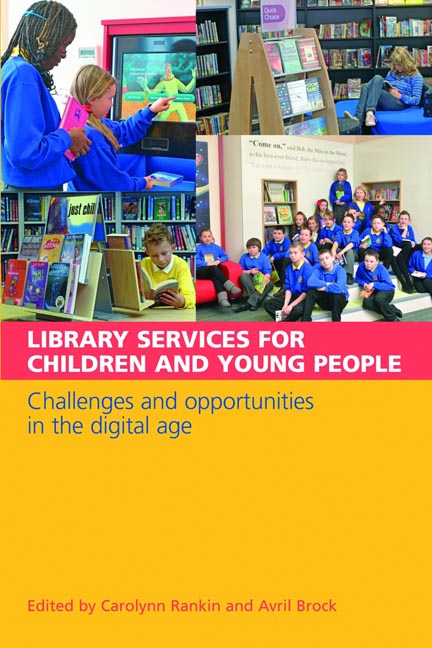Book contents
- Frontmatter
- Dedication
- Contents
- Contributors
- Foreword
- Acknowledgements
- Introduction and vision for the book
- Part 1 Children's library services – policy, people and partnerships
- Part 2 Connecting and engaging – reaching your audience and catching the latest wave
- Part 3 Buildings, design and spaces – libraries for children and young people
- 11 Library space and place transformation – designing for the digital natives
- 12 Making space for reading – designing library spaces for children in public and school libraries
- 13 Case study. Imagine, explore, discover – welcome to The Trove at White Plains Public Library, New York
- Part 4 Issues for professional practice
- Index
11 - Library space and place transformation – designing for the digital natives
from Part 3 - Buildings, design and spaces – libraries for children and young people
Published online by Cambridge University Press: 08 June 2018
- Frontmatter
- Dedication
- Contents
- Contributors
- Foreword
- Acknowledgements
- Introduction and vision for the book
- Part 1 Children's library services – policy, people and partnerships
- Part 2 Connecting and engaging – reaching your audience and catching the latest wave
- Part 3 Buildings, design and spaces – libraries for children and young people
- 11 Library space and place transformation – designing for the digital natives
- 12 Making space for reading – designing library spaces for children in public and school libraries
- 13 Case study. Imagine, explore, discover – welcome to The Trove at White Plains Public Library, New York
- Part 4 Issues for professional practice
- Index
Summary
Introduction
Libraries today aim to attract children and young people, with a range of services and facilities appealing to the particular age groups. This includes a welcoming physical space, a rich mixture of books, computers and a range of activities and services. According to Lushington (2008, 8), successful children's library design in the 21st century will do the following:
• give children a choice when selecting their own materials to take home
• provide a comfortable place to use computers and do homework
• provide a variety of attractive programme and activities
• support the work of talented and well-trained children's librarians.
Added to this is the provision of a welcoming place to ‘hang out’ and socialize, particularly for teenagers and young people, who want to develop their independence. As discussed in Chapter 1, there are challenges facing public libraries in the digital age, as many other activities are competing for family time, and young people have opportunities to access knowledge and resources, without using the library. The children and young people of today represent the first generation to grow up spending their entire lives surrounded by, and using, computers, video games, digital music players, video cams, cell phones and all the other toys and tools of the digital age. Prensky (2001, 1) has designated this generation as the digital natives – all ‘native speakers’ of the digital language of computers, video games and the internet.
This chapter considers the design approaches that libraries have used and discusses what makes for a good design in children's libraries and library spaces designed for teenagers and young people. The challenges and opportunities relating to library space design for the five to 18 age range are discussed. The common factor relates to the use of the actual space, which brings the community under the same roof. The chapter is not attempting to be comprehensive, particularly in view of the differing needs and expectations of the wide age range, but rather is aiming to give examples of innovative practice and to suggest other sources of information. The focus will be on provision in public libraries, but it is important to also mention school library provision. Librarians have responded to the challenges brought about by the information age, and this chapter will discuss examples of innovative and successful designs from the UK and other parts of the world.
- Type
- Chapter
- Information
- Library Services for Children and Young PeopleChallenges and opportunities in the digital age, pp. 159 - 182Publisher: FacetPrint publication year: 2012
- 1
- Cited by



